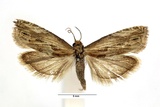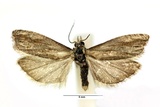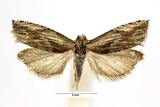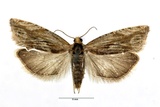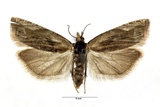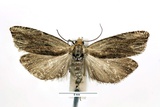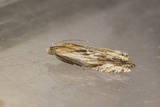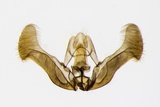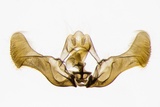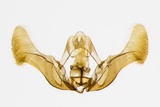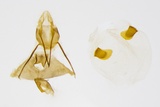Eucosma cana (Haworth, 1811) Species
Last modified: Dec. 5, 2023, 10:29 a.m.
A common species throughout Belgium, especially in the northern part.
Details
- Classification
- Family: Tortricidae > Subfamily: Olethreutinae > Tribus: Eucosmini > Genus: Eucosma > Species: Eucosma cana
- Vernacular names
- Distelknoopvlekje (NL), Hoary Bell, Hoary Tortrix (EN), Distel-Blütenwickler (DE)
- First mention in Belgium
- De Crombrugghe G. 1906a. Catalogue raisonné des Microlépidoptères de Belgique. — Mémoires de la Société entomologique de Belgique XIII: 1–172; XIV: 1–155. On page 129.
- Status
-
Native
Distribution
Imago
Wingspan 15–23 mm. It is a larger Eucosma species with relatively narrow wings. They are variably coloured and patterned but distinctively show longitudinal striping. The ocellus may have black marks.
Very similar to Eucosma hohenwartiana but differs by the paler ground colour of the forewing and the distinctive longitudinal lighter streaks.
Caterpillar
The larva is 10–11 mm long, with a dark ocher head and prothoracic shield, brown ocher tinged with the rest of the body.
Bionomics
Eggs on the outside of blossoming heads. The young caterpillars bore into the flower head and feed on both plant tissue and on Tephritidae species that have already pupated at this point. The late larva bores a frass-filled tunnel in the flower base and then crawls out. The larvae hibernate in a cocoon spun amongst leaf-litter or in the soil and pupate in this cocoon.
The adults are active from late afternoon and come to light.
Flight periods
The adults have been seen from early May towards late September, with a peak during June/July.
Observed on
- Host plant (species):
- Cirsium vulgare and Galactites tomentosus
- Host plant (genera):
- Carduus, Centaurea and Cirsium
The larvae live on Cirsium vulgare, Cirsium spp., Carduus spp., Galactites tomentosus and Centaurea spp.
Habitat
They can be found on open flower meadows, waysides, rough ground and uncultivated land.
